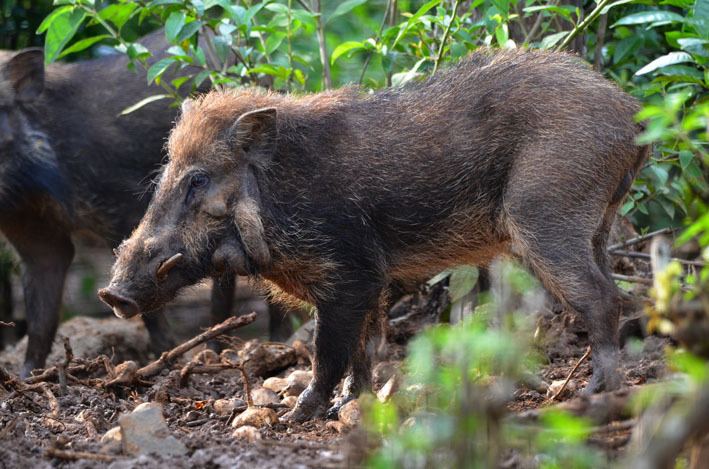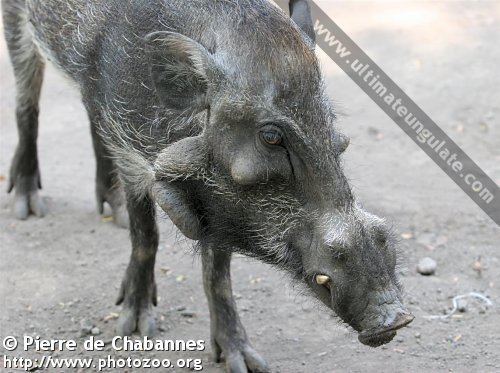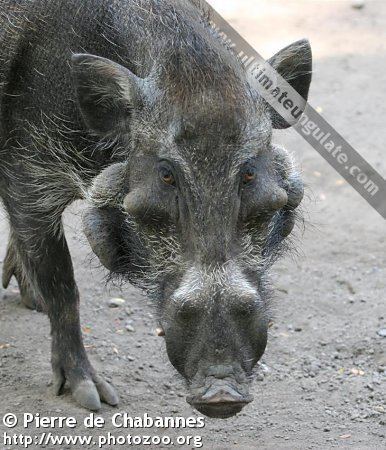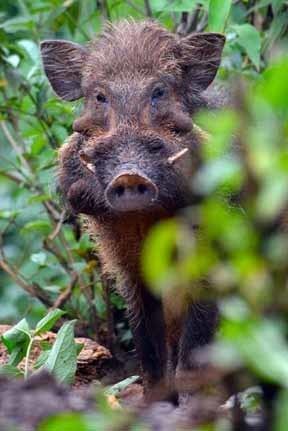Order Artiodactyla Genus Sus Scientific name Sus verrucosus Lifespan 8 years Length 90 – 190 cm (Adult) | Phylum Chordata Species S. verrucosus Mass 44 – 110 kg (Adult) Gestation period 122 days Higher classification Pig | |
 | ||
Similar Celebes warty pig, Philippine warty pig, Oliver's warty pig, Visayan warty pig, Pig | ||
The Javan warty pig or Javan pig (Sus verrucosus) is a species of even-toed ungulate in the family Suidae. It was originally endemic to the Indonesian islands Java, Bawean, and Madura, but has recently been found extinct in Madura. Sus verrucosus lives in fragmented teak forest regions ranging in altitudes from sea level to 800 m above sea level.
Contents
- Physical characteristics
- Behavior
- Feeding
- Reproduction
- Conservation status
- Conservation efforts
- References

Physical characteristics

The Javan warty pig ranges from 44 to 108 kg in weight and from 90 to 190 cm long. Their pelage is red near the tip and a yellow or white color at the base of the hair. All members of this species have long manes on top of their heads that follow their spines down their backs to their rumps. The tail of the Javan pig has a tuft of long, red hairs at the end. The build of this animal is skinny legs and a large, oblong body. The most distinguishing feature of the males of Sus verrucosus is the three pairs of facial warts, the preorbital, infraorbital, and the mandibular, which is the largest. As the pigs age, the warts grow in size, so the eldest Javan pig has the largest warts.
Behavior

The Javan warty pig is mainly a solitary creature, but sightings of groups of three or four individuals have been made. They are nocturnal (most active at night) and crepuscual (also active during dusk and dawn). When the warty pig is startled, its mane stands erect. If the animal is fleeing from a predator, its tail is erect and curved towards its body. When a group of individuals is frightened, the recorded alarm call of the pig sounds like a shrill whistle. On average, the species lives to be eight years of age, with a few individuals living to 14 years of age.
Feeding

Sus verrucosus is an omnivore, feeding on vegetables, crops, and small mammals. Some vegetation they consume includes roots, tubers, bark, seeds and grains. They also raid farmers fields and are considered an agricultural pest.
Reproduction

The specific mating structure of this species has not been observed, but is believed to be polygynous (males compete and mate with multiple females within a breeding season) like other members in the genus Sus. In the genus Sus, species become reproductively mature around 9 months old, but females normally begin mating at 1.5 years old while males wait to reach full size at age 5 to be able to compete for a mate. The mating season of this species is from September through December. The gestation period for the Javan warty pig is four months. During January through April, the rainy season in Indonesia, the sows give birth to liters ranging from three to 9 piglets. The piglets are born into a nest and nursed for the following three to four months.
Conservation status
According to the IUCN Red List, S. verrucosus was first declared vulnerable in 1988 and listed as endangered in 1996. A drastic 53% drop in the population occurred from 1982 through 2006. The species is believed to be still declining. A recent study estimated a population of 172-377 individuals, making the Javan warty pig one of the rarest pig species. The main threat to this species is habitat encroachment by humans. Agriculture is a large influence in the decline of the Javan warty pig. These pigs are also killed by farmers who spot the pigs raiding their crops at night. Since this is a large animal, sports hunters also consider killing the animal a challenge and see it as a trophy. An interesting threat to this species is actually occurring naturally. The closest relative to Sus verrucosus is the banded pig (Sus scrofa). This species shares similar habitat ranges as the Javan pig. This species threatens the Javan pig not only through resource competition, but also by cross-mating and creating hybrids of S. verrucosus and S. scrofa.
Conservation efforts
The most recent conservation project, through the World Association of Zoos and Aquariums, aims to capture healthy Javan pigs and breed them in captivity. The offspring of this program are then supposed to be released into protected habitats. This method of reintroduction of the offspring will ensure the long-term survival of the species. One of the problems with this project is finding true S. verrucosus, not hybrids, which brings up another goal of the program, molecular mapping. Scientists will extract DNA from the wild pigs and record their genetic code to separate hybrids from true S. verrucosus. Along with this project are plans to educate the locals of the importance and endangerment of this species. The locals sometimes comment that they cannot distinguish the banded pig from the Javan pig, and with education this confusion can be reduced.
